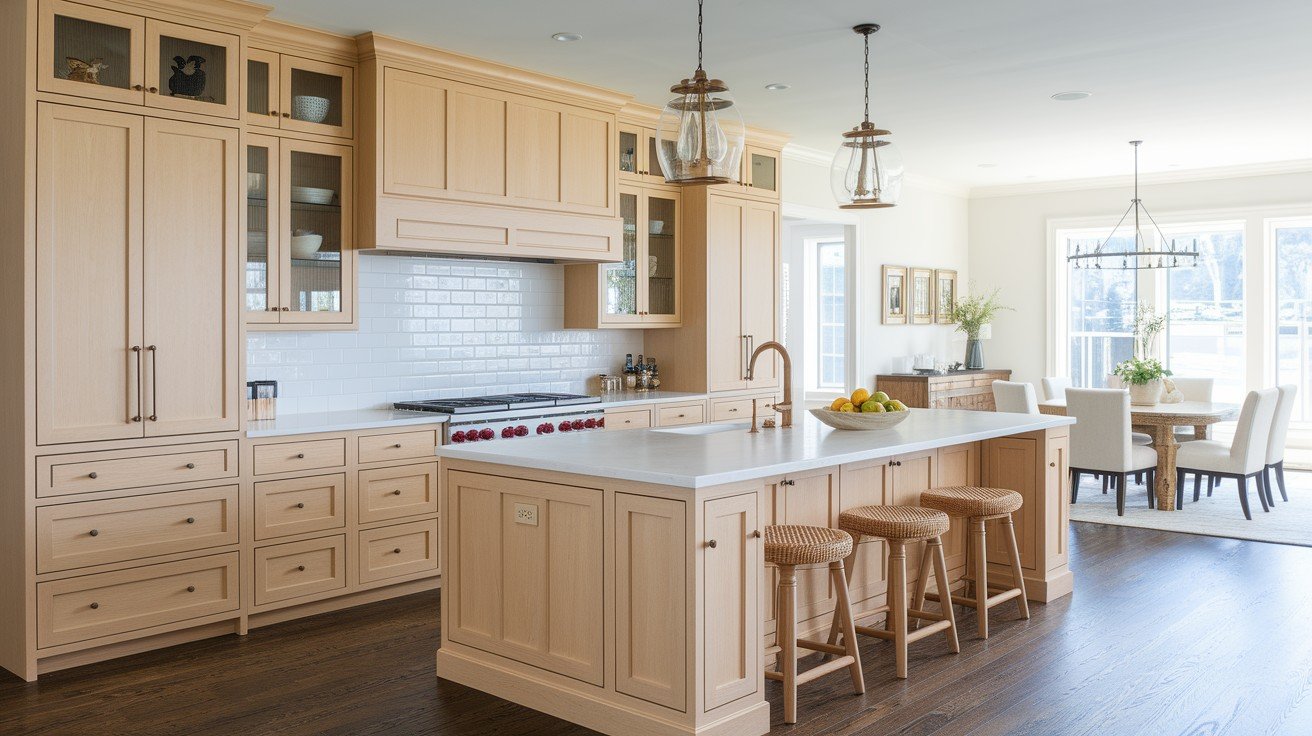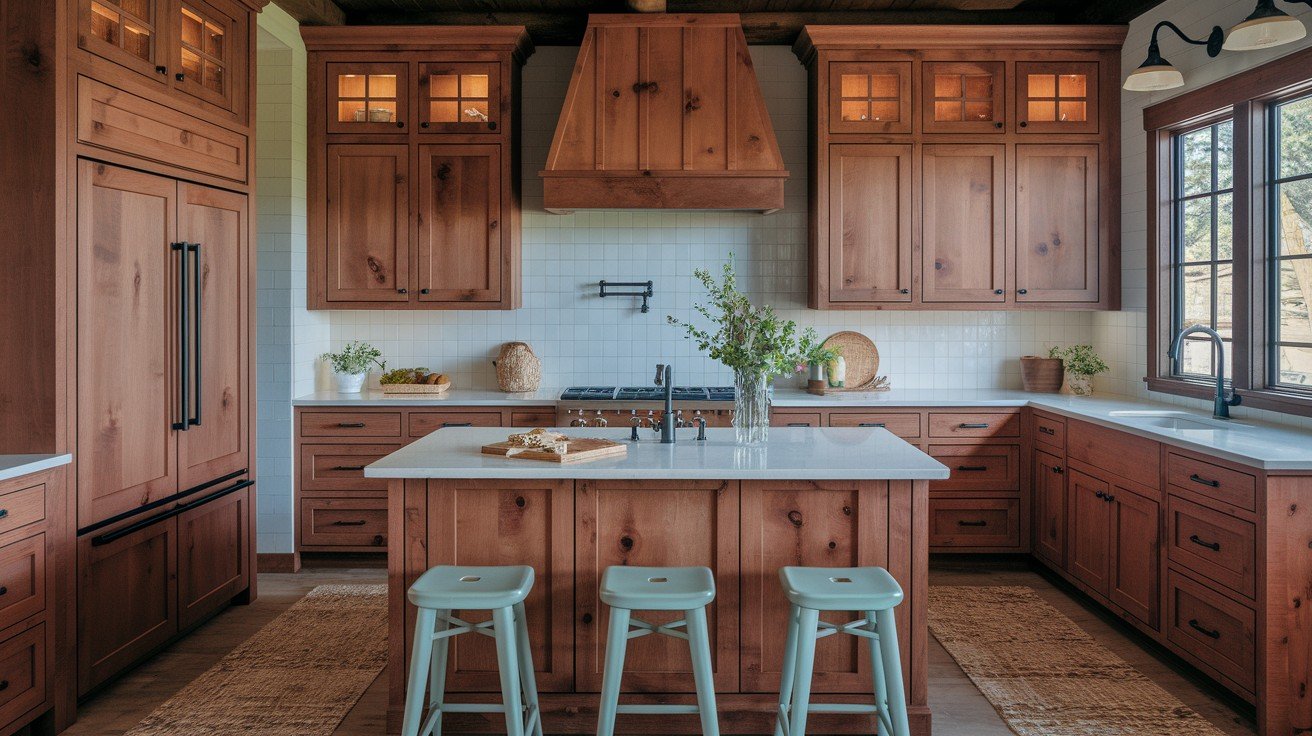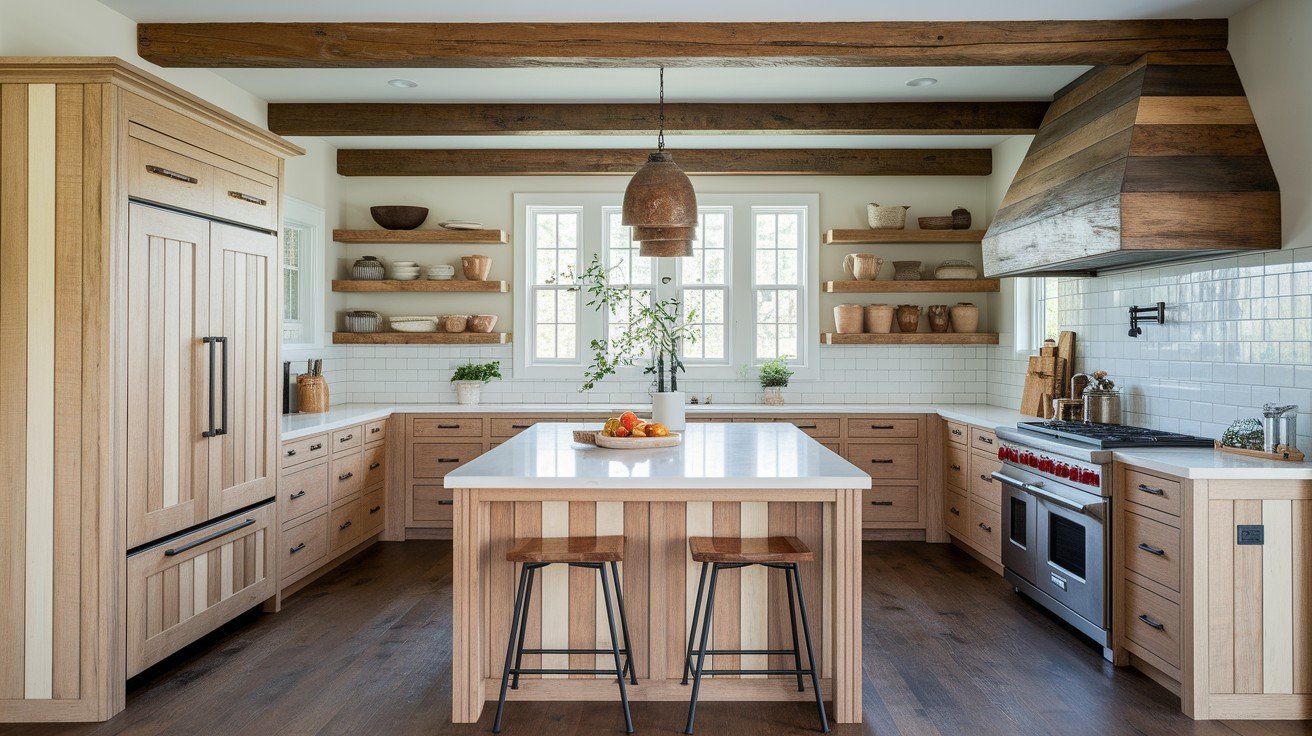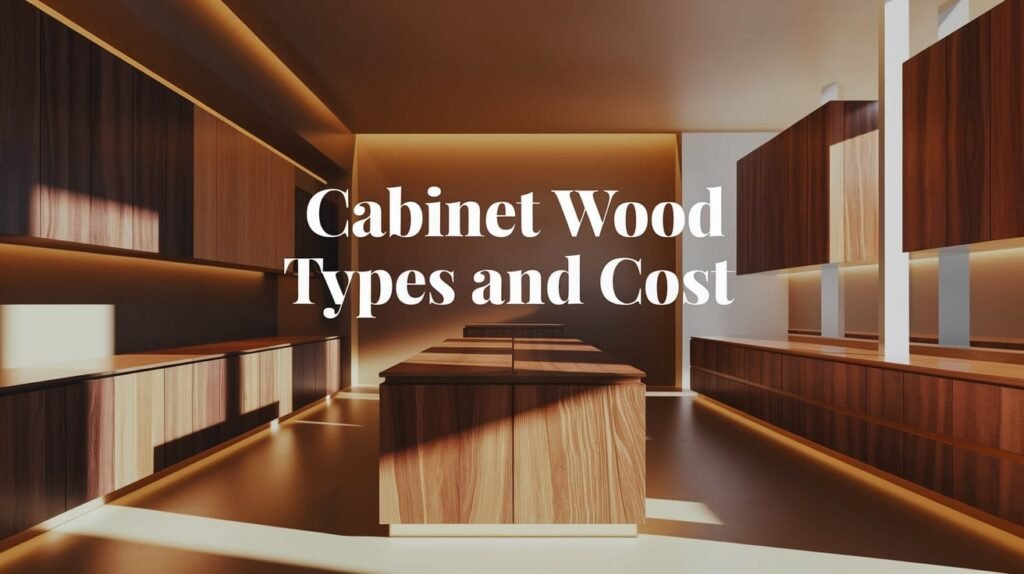Planning a kitchen makeover? Your cabinet wood choice will make or break your budget.
We get it. Walking into a showroom and seeing price tags that range from $22 to $60+ per square foot can be overwhelming. Why does maple cost $27 while walnut costs $38? What makes MDF only $22?
You need straight answers about cabinet wood types and costs. No sales pitch. Just facts.
We’ve spent years working with homeowners who faced the same confusion. Our research covers real pricing data from multiple suppliers. We’ve seen which woods hold up over time and which ones don’t live up to their price tags.
Here’s what you’ll learn: The top 7 cabinet woods and their exact costs, why certain woods cost more than others, which wood gives you the best value, and budget-friendly alternatives that still look great.
Let’s cut through the confusion and help you make a smart choice for your kitchen and wallet.
7 Cabinet Wood Types
This section breaks down the 7 most popular cabinet woods, showing you exactly what each costs per square foot and which one fits your budget and style needs.
1. MDF

Cost: $22 per square foot
Let me be honest with you. MDF isn’t real wood. It’s made from wood fibers pressed together with resin. But here’s the thing – it might be exactly what you need.
MDF gives you a perfectly smooth surface every time. No knots. No grain patterns. No surprises. This makes it ideal for painted cabinets where you want that flawless finish.
Here’s what makes MDF special: It cuts cleanly without splintering. You can create detailed shapes and decorative elements that would cost a fortune in solid wood. Custom millwork becomes affordable.
But there’s a catch.
MDF is a manufactured wood product with no natural grain. It has a smooth, uniform surface that’s ideal for painting. When properly sealed, it resists moisture and heat well.
The downside? If it gets damaged, you can’t sand it down and refinish it like real wood. Scratches and dents are permanent.
I recommend MDF when you’re painting your cabinets and need to stick to a tight budget. It’s also perfect for intricate door designs where solid wood would break your bank.
Best for: Painted cabinets, tight budgets, custom shapes
2. Red Oak

Cost: $26 per square foot
Red oak has been America’s go-to cabinet wood for decades. There’s a good reason why.
You’ll recognize red oak instantly by its bold flame-like grain patterns. The wood has a subtle reddish tint that gives kitchens a warm, welcoming feel. It’s lighter in color than white oak, which makes it perfect for staining.
Here’s the best part: Red oak is everywhere. This high availability keeps prices reasonable compared to exotic woods.
Red oak is an open-grain wood with distinctive flame patterns. It has a subtle reddish hue and stays lighter than white oak. High availability keeps costs reasonable for most budgets.
But remember this – open grain means more porous. Red oak soaks up moisture faster than denser woods. It needs proper sealing, especially around sinks.
I’ve seen red oak cabinets last 20+ years when properly maintained. The grain takes stain beautifully, letting you achieve rich, deep colors.
Best for: Traditional kitchens, stained finishes, moderate budgets
3. Maple

Cost: $27 per square foot ($2,500-$6,000 for 10×12 kitchen)
If I had to pick one wood for most kitchens, maple would be it.
Maple gives you the best of both worlds. It’s affordable enough for tight budgets but durable enough to last decades. The light, creamy color works with any style – from farmhouse to ultra-modern.
Want to stain it dark? Maple takes it perfectly. Prefer it light? The natural color is beautiful on its own.
Maple has a light, creamy white color with a fine texture. It takes stains exceptionally well across the spectrum. The wood offers high durability and excellent moisture resistance.
Here’s what makes maple special: It’s incredibly hard and dense. This means it resists dents and scratches better than softer woods. Your kids can bang cabinet doors without leaving permanent marks.
The downside? Maple can yellow slightly with sun exposure over time. But this happens slowly and isn’t noticeable in most kitchens.
Best for: Contemporary styles, versatile staining, long-term value
4. Alder

Cost: $28 per square foot
Want the look of cherry without the price? Alder is your answer.
Woodworkers call alder “poor man’s cherry” for good reason. It has that same reddish tone that makes kitchens feel rich and warm. The smooth grain takes stain beautifully.
You can choose between smooth alder or knotty variations. Knotty alder adds rustic character that works perfectly in farmhouse or cabin-style kitchens.
Alder has a reddish tone similar to cherry, earning the nickname “poor man’s cherry.” It features smooth grain and comes in knotty variations. While softer than other hardwoods, it remains budget-friendly.
But here’s the trade-off: Alder is softer than premium hardwoods. It dents and scratches more easily than maple or cherry. This makes it better for moderate-use kitchens.
I recommend Alder when you love the cherry look but need to watch your budget. It’s also perfect for second homes or rental properties where you want style without the premium cost.
Best for: Rustic styles, cherry look on a budget, moderate use kitchens
5. Cherry

Cost: $30 per square foot
Cherry is the wood that makes people stop and stare. There’s something magical about its rich, deep color.
Fresh cherry starts as a light golden color. But here’s where it gets interesting – cherry darkens naturally over time. Sunlight turns it into that gorgeous deep reddish-brown you see in high-end furniture stores.
Cherry has a rich, upscale dark color ranging from deep yellow to pale red. It features straight, closed grain with smooth texture. The wood naturally darkens with age and sun exposure.
The grain is incredibly smooth. No wild patterns or dramatic streaks. Just clean, straight lines that give kitchens a sophisticated look. This makes cherry perfect for traditional and transitional styles.
Here’s what you need to know: Cherry costs 15-25% more than maple or oak. But it lasts a lifetime when properly cared for. I’ve seen 30-year-old cherry cabinets that still look brand new.
The aging process can be unpredictable. Some boards darken faster than others, which can create slight color variations.
Best for: High-end kitchens, traditional styles, lifetime investment
6. Hickory

Cost: $30 per square foot
Hickory is the toughest wood on this list. With a hardness rating of 1820 on the Janka scale, it’s nearly indestructible.
What makes hickory special is its unique two-toned appearance. You’ll see natural streaks of light white and darker reddish wood in the same board. This creates a rustic, natural look that’s impossible to fake.
Hickory features a unique two-toned appearance with natural streaks. It has an extremely high hardness rating of 1820 Janka. The tight grain is typically finished with clear sealers.
The grain is tight and dense. This means the stain doesn’t penetrate evenly, so most people finish hickory with clear sealers. This lets the natural color variations shine through.
I recommend hickory for busy families with kids and pets. It handles daily abuse better than any other wood. Dropped pots, banging doors, scratches from pets – hickory takes it all and keeps looking good.
The downside? The color variations can be dramatic. Some people love this natural look, while others prefer a more uniform appearance.
Best for: Rustic designs, high-traffic kitchens, decades-long durability
7. Walnut

Cost: $38 per square foot
Walnut is the top-tier option for cabinet woods. When you want to make a statement, nothing beats its rich chocolate tones.
The color ranges from deep, dark brown to reddish gray. Each board tells its own story with swirling grain patterns that look like works of art. The straight, smooth grain features intricate details you won’t find in other woods.
Walnut ranges in color from dark brown to reddish gray. Natural oils provide scratch and fingerprint resistance. It has straight, smooth grain with intricate swirl patterns.
Here’s walnut’s secret weapon: Natural oils in the wood resist scratches and fingerprints. Your cabinets will look cleaner longer, even with heavy use. No other wood offers this natural protection.
Walnut works with any style. Modern kitchens love their clean lines. Traditional spaces appreciate their rich warmth. It’s the most versatile premium wood you can buy.
The reality check: Walnuts cost significantly more than other options. It also requires more maintenance to keep those natural oils working properly.
Best for: High-end kitchens, modern or traditional styles, showcase pieces
Conclusion
Your cabinet wood choice comes down to three things: budget, style, and how long you want them to last.
MDF at $22 per square foot works great if you’re painting and watching every dollar. Maple at $27 gives you the best bang for your buck with solid durability. Walnut at $38 brings luxury but costs more upfront.
Remember this: Wood type affects your total cost more than door style. Switching from walnut to maple saves you more money than changing from raised panel to shaker doors.
Don’t make this decision alone. Get separate quotes for each wood type you’re considering. Prices change based on availability and your location.
The right wood exists for every budget. Whether you spend $22 or $38 per square foot, you can create a kitchen you’ll love for years to come.
Frequently Asked Questions
What’s the cheapest wood for kitchen cabinets?
MDF at $22 per square foot is most affordable, followed by knotty pine at $23 per square foot for natural wood options.
Which cabinet wood offers the best value?
Maple provides excellent durability, versatility, and moderate pricing at $27 per square foot, making it the best overall value choice.
Do expensive woods last longer than cheaper options?
Generally yes. Premium hardwoods like cherry, hickory, and walnut offer superior durability compared to softwoods and manufactured materials like MDF.
Can I save money by choosing simple door styles?
Wood type affects the cost more than door style. Switching from expensive walnut to affordable maple saves more than changing door designs.
How much should I budget for a complete kitchen?
Plan $2,500-$6,000 for a 10×12 kitchen with mid-range maple cabinets, though costs vary significantly based on wood choice and features.

